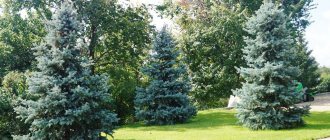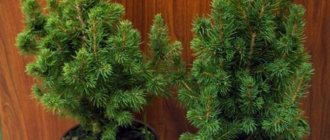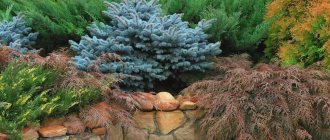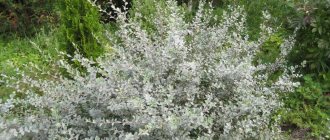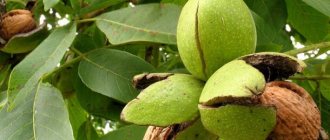Willow pendula will give the garden a special charm
Perhaps everyone has at least once seen majestic, luxurious willows on the river bank, bending their long lashes towards the water. But did you know that not all of them are impressive in size, especially in height? Thanks to the efforts of breeders and such cunning procedures as grafting and standard formation, pendula willow appeared. This culture is the dream of any owner of a modest plot. Having retained its graceful weeping crown, the willow has turned into a compact tree and does not require much space. True, it will need more attention to maintain the density of the crown, especially in terms of pruning.
Disease and pest control
The plant is very resistant to various diseases, but some of them can still affect the bush. These include:
- powdery mildew;
- rust;
- scab.
With powdery mildew, a white coating appears on the leaves of the plant. Bushes are treated using fungicides. When the weather is too wet, the leaves begin to turn black and then die completely. These are the first signs of scab disease. The affected areas of the plant are removed, and the bush is treated with a fungicide.
Rust is a fungal disease of leaves . It can be identified by the appearance of red spots. The affected parts of the plant are removed and must be burned. Among the pests, it is worth noting the willow moth, leaf beetle and silkworm. Caterpillars of the moth butterfly eat the leaves of a bush. To combat them, insecticides are sprayed.
The leaves are also eaten by leaf beetles. For the winter, these beetles burrow into the ground near plants. Therefore, it is recommended to burn straw and old leaves in these places. Silkworm butterflies lay eggs on the leaves of bushes. The emerging caterpillars destroy all green growth. To combat them, it is recommended to attract sparrows and bats or collect the pest manually. With good care, willow grows into a very beautiful, decorative bush, which can be used as a hedge or to strengthen the banks of a reservoir. It will decorate any area.
Characteristic features of the tree

Willow pendula differs from its relatives growing in natural conditions in the height and shape of the crown. Most often, such plants are standard, which allows you to regulate and give them the desired height. As a result of grafting, a standard is formed, which determines the “growth” of the willow. The lower the standard, the lower the tree itself will be. On average, the height of the pendula is from 1.5 to 3 m. Moreover, it also has a lush and dense crown in the form of a ball with a diameter of 1.5 m. It must be formed at a young age through regular and correct pruning.
Common willows found in parks and private lands include goat willow, white willow, and purple pendula willow.
Biological description of Pendula larch
Pendula belongs to one of the varieties of European larch. This is a fairly large tree, which in natural conditions (forests of Central and Western Europe) can reach a height of up to 8 m. However, in cultural conditions, the average specimen does not exceed 6 m, while the crown diameter is no more than 1 m.

The weeping cylindrical crown is one of the most striking distinctive features of the tree. Shoots often form from a small apical growing point and then grow into elongated pendulous branches with several small lateral branches as they develop. The needles of the plant are soft and pleasant to the touch, collected in bunches.
During the active phase of the growing season, the coniferous cover has a rich bluish-green hue. In autumn, the color of the needles changes to golden, after which the tree sheds them at the end of the season. Pendula has a trunk of various brown tones, while the shoots are characterized by a red-brown tint.

Willow pendula - secrets of growing and care
Like other varieties, pendula prefers well-moistened and fresh soil. It grows better and keeps foliage longer on loam, but excess lime in the soil is contraindicated for it. It needs regular and abundant watering and responds well to the addition of mineral complexes. Another important advantage of the species is its good resistance to diseases, pests, and frost. It winters well without shelter, with the exception of winters when there is little snow and sudden temperature changes.
To achieve the weeping shape characteristic of pendula, the willow must be pruned correctly. Otherwise, its branches will simply lie on the ground and will be sparse.
Crown formation can be done in two ways:
- At the end of spring, after flowering has completed, cut off the young growth shortly, leaving no more than 20 cm. In this case, you need to pay attention to where the upper bud is facing (at the tip of the cut shoot). In order for the crown to look like a spreading umbrella, the bud should look up and to the side.
- Throughout the summer, pinch out young branches after they reach a length of 15 cm. In this case, the density of the crown will be achieved due to branching.
And one more point: in standard willows it is necessary to completely remove the growth that appears below the grafting. Then the tree will retain its decorative shape.
Purple willow care
Willows grow quite quickly; some species can grow up to three meters annually. Therefore, they require proper care throughout the season. The most active care should be taken during the first time after planting. The following activities must be carried out:
- watering;
- feeding;
- pruning;
- preparation for winter.
This plant, especially young ones, must be watered regularly at least once a week, pouring 20 to 50 liters of water under each bush. Watering is carried out before sunrise or sunset. At the same time, not only the root system is watered, but also the crown of the bush. After this, you need to loosen the soil around each planting. During the season, the plant is fed two or three times. For this, complex mineral fertilizers are used.
At the end of summer, plants are fed with superphosphate and potassium sulfate. Willow pruning begins in the second or third year. The formation of bushes is carried out in the spring and after flowering. Don’t be afraid to cut branches; willow tolerates pruning well and recovers quite quickly. Purple willow is frost-resistant, but young plantings must be covered for the winter.
Willows are different. My favorite is the goat Pendula.
In my opinion, Pendula goat willow is a stunning ornamental plant to add to your garden! Having once seen a photo on the Internet, I firmly decided to plant this beauty on my site.
The height of this plant depends on the grafting, very often it is 1.5 meters. It grows quite quickly, 5-10 cm per year in height, and 10-20 cm in width, but the branches grow even faster in length - up to 1 m per season. The crown shape is tent-shaped, with shoots hanging down, and can reach a diameter of 1.5 meters. Willow has very interesting oval leaves 6-8 cm, covered with gray-white fibers. For the correct formation of the crown, you need to trim the shoots in the first 3-4 years, leaving only 30-40 cm in length, so that at the ends of the branches there are buds looking up and to the sides, then the crown will look like an equilaterally developed umbrella. You can prune after flowering in early spring. Willow is sun-loving, but can also grow in partial shade. This is how it hides behind my peonies.
Pendula in garden design
In 1836, scientists discovered the European larch pendula. From that moment on, gardeners in Europe began to actively use it in their work due to its decorative appearance. It is good both in group and single plantings. Trees obtained by grafting are not tall. Their height usually does not exceed the height of the trunk and is approximately one and a half meters. The tree reaches one meter in width .
The crown has excellent twining branches, with minor lateral branches. The color of the needles is green with a bluish tint. In autumn the needles fall off. The cones are colorful, males are golden in color, females are red. Pendula is incredibly beautiful, has a delightful pine aroma, soft and delicate needles. Looks great even in the absence of pine needles in winter. Because the shape of the branches, strewn with short shoots and tubercles, with small variegated cones, creates an original “lace” that decorates the snow-covered garden in its own way.
Pendula is light-loving and can withstand winter cold well. Prefers alkaline, moist and fertile areas. When planting, you must carefully close the planting hole. In hot summers, generous watering is required.
Every spring in the first four years after planting the tree in the ground, it is necessary to prune annual growths in order to build up a lush crown. To obtain a multi-tiered tree, fresh shoots should be tied to a vertical support for three years.
Standard pendula larch is universal in design, since the color of its even bluish-green needles can become the background for creating eye-catching compositions. The tree goes well with groups of other types of trees, including deciduous trees, shrubs and other ornamental garden plants. It looks great on lawns and next to bright flower beds.
Pendula is resistant to air polluted by industrial emissions and vehicles, so it can be used as a plant that protects the environmental well-being of the urban environment.
Description White willow 'Pendula'
Large, not particularly decorative trees that require a lot of space have long given way to the list of popular garden forms and are more often found in parks than in private properties, and only a few types of willow remain in demand today.
But among the diverse and very similar representatives of this family, the weeping form of goat willow “Pendula” stands out for its amazing decorativeness, which today is considered one of the most original weeping representatives of woody plants.
The goat willow itself is quite inconspicuous: growing in swamps, on the banks of natural reservoirs and streams, in the lowlands of rivers, the rather pale and modest plant is so loved by goats that it received its eloquent name “goat willow”.
But a moisture-loving willow grafted onto a trunk is literally transformed: a massive canopy of hanging branches, superbly contrasting with the lawns and water surface, looks very original and bewitching.
This is one of the best small crops for decorating alpine hills and ponds, which captivates with its calm greenery, charming flowering, during which bare arched branches are covered with elongated fluffy earrings of light golden tones, similar to fancy, well-fed caterpillars and a yellow autumn outfit.
Let's take a closer look at the amazing weeping goat willow and the peculiarities of its cultivation.
Life form: Deciduous tree
Crown: Tent-shaped or weeping, medium.
Growth rate: Fast. The annual growth is 100 cm in height and 50 cm in width.
Height 30 m, crown diameter 20 m.
Durability: 100 years
Flowers: Flat, irregular, yellow-green, 0.3 cm.
Leaves: Lanceolate, silvery-white in spring, dark green in summer and autumn, from 5 to 15 cm.
Decorative: White willow 'Pendula' has beautiful foliage and crown shape.
Use: Alleys, single plantings, decorative groups.
Growing conditions White willow 'Pendula'
Attitude
to the light: photophilous
to moisture: medium-demanding
to soil: not demanding
to temperature: frost-resistant
Homeland: Europe, Central Asia.
Planting and care
White willow 'Pendula' 'Tristis' goat 'Pendula' brittle purple 'Nana' 'Pendula'
Planting features: Most willows are light-loving and grow better in open places. Goat willow is shade-tolerant and grows normally in partial shade.
Soil mixture: Soils can be different: sandy, swampy, not very fertile, gravelly. Drainage is required on heavy clays, a layer of 20-30 cm of sand or crushed stone. Optimal soil acidity pH is from 5 to 7.5.
Weeping larch: secrets of planting and care
Unpretentiousness, rapid growth, durability are the indisputable advantages of weeping larch.
The plant is able to withstand cold, is not picky about the soil, and can be grown in almost all climate zones. These trees live for six hundred years and grow up to forty meters in height. Larch has the ability to absorb harmful gases and helps cleanse the atmosphere, enriching it with beneficial phytoncides. This tree has medicinal properties and has a beneficial effect on human health. Larch always looks luxurious, which makes the tree an indispensable material for decorating gardens and parks. In landscape design it has a number of advantages. The sun's rays pass through the needles well. Therefore, the tree does not create shade for other garden plants. Larches with a weeping crown are perfect for small garden plots. Because these plants reach only eight meters in height. In late autumn, these trees shed their needles like deciduous trees - this is another advantage in landscape design. Because this tree is much easier to care for than other conifers. Because in the autumn you can trim the shoots and give the larch crown a beautiful shape and adjust the size. In Japan, larch is most often used to create bonsai.
Young, tender light green and blue needles appear on the branches in the spring. The color of the needles depends on the type of tree. Soft needles grow in beautiful tufts. The tree has peculiar cones that give the branches a special attractiveness. Planting decorative larches does not require a large area.
